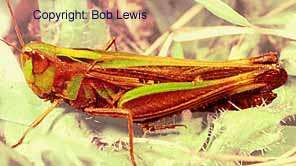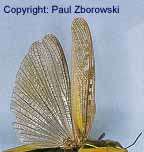Adult description 14 of 15


Size: Females 25 to 30 mm, males 15 to 20 mm long.
Adult Description: Colour varies from deep brown grey to green and brown. In profile the head, thorax and wings are fairly level and the thorax does not have a 'saddle' shape as in plague locust, though it does have a thin 'X' mark from above. The hind wings from the side are uniformly dark and usually brown. Rear wings are coloured with a dark grey-brown sooty smudge almost all over. A small black triangle extends down from the eye, pointing slightly forward. The rear leg tibia is brown with a slight stripe below the 'knee'. Throat peg absent.
Confusion with Australian plague locust and Austroicetes: Similar size and shape, some colour combinations and the 'X' mark on top of the thorax (compare photos).
Unique features: The combination of the 'X' mark on top of the thorax with unpatterned dark wing covers and sooty dark hind wings. The rear tibia brown, rather than red as in plague locusts or yellow-red as in Austroicetes. Although wide ranging, Caledia is more likely to be encountered in wetter coastal areas.
Further information on this species: Description of nymph
